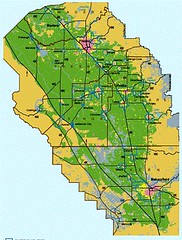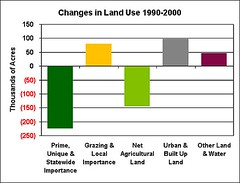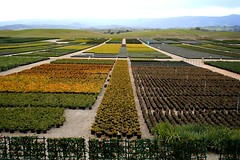Great smart growth story ranks communities in the San Joaquin Valley

Posted November 6, 2008 at 10:15PM
 The Modesto Bee has an impressively documented story, complete with interactive maps and video, rating the smart growth performance of some 60 cities and towns in California's San Joaquin Valley. Each jurisdiction is rated on nine factors:
The Modesto Bee has an impressively documented story, complete with interactive maps and video, rating the smart growth performance of some 60 cities and towns in California's San Joaquin Valley. Each jurisdiction is rated on nine factors:
- Development (sprawl versus smart)
- Agriculture and open space
- Infrastructure and transportation
- Affordability
- Economic planning (including jobs-to-housing ratio)
- Fees (does development pay its way?)
- Design
- Amenities
- Outreach
The San Joaquin is the southern half of the Central Valley, the nation's most productive farming region.
The overall winner was Oakdale, a community of about 19,000 southeast of Stockton. The story commended Oakdale's formal greenbelt buffer with nearby Riverbank, along with superior neighborhood design, historic preservation and decent affordable housing policies. The analysts found that "Oakdale is second to none in transportation and parks and scored near the top in economic planning and fees charged to developers."
At the bottom was Gustine, a town of about 5,000 south of Modesto, scoring poorly in several categories and apparently also annoying the reporters for failing to respond at all to parts of the paper's questionnaire (heh). Of McFarland, another poor-scoring town of about 12,000 north of Bakersfield (shout out to Merle Haggard, Dwight Yoakam and the late Buck Owens), the authors note that the community has "virtually no design guidelines, public plaza or stores. The community's sewer and water systems need upgrading. Scores are bound to improve soon, once its general plan is updated."
 While most any ranking is going to have imperfections, the Bee's story is both informative and fun, and well worth checking out.
While most any ranking is going to have imperfections, the Bee's story is both informative and fun, and well worth checking out.
Moreover, it is good to see smart growth being recognized in the Central Valley, which has been experiencing high rates of sprawl, to the detriment of some of the nation's very best farmland. The American Farmland Trust, in another well-documented report, has estimated that in the 1990s the Valley lost about 223,000 acres of high quality farmland, most of it permanently converted to other uses. (Some was reclassified by the state Department of Conservation as less productive because it is no longer irrigated.) See the bar graph above, which depicts farmland loss in green and growth in developed land in gray.
Moreover, AFT reports that over half the land that was developed for urban and suburban purposes in the Valley in that period was considered "high quality farmland" and, "in five counties -- including San Joaquin and Stanislaus, two of the Valley's fastest growing counties that are also among the top 10 agricultural  producers in the United States -- more than 75 percent of all the land developed was high quality land." (The story in the Bee also ranked counties, with San Joaquin scoring second out of eight and Stanislaus ranking fifth.)
producers in the United States -- more than 75 percent of all the land developed was high quality land." (The story in the Bee also ranked counties, with San Joaquin scoring second out of eight and Stanislaus ranking fifth.)
AFT notes that the Sacramento Blueprint can serve as a good model for the kind of enlightened planning needed in the Valley, and also expresses hope for the California Partnership for the San Joaquin Valley, a cooperative endeavor created by an executive order in 2005.
AFT, like NRDC one of the original founders of the Smart Growth America coalition, has been doing great work on the Valley for years, along with their excellent work on these issues nationwide.
Many thanks to my colleague Justin Horner for pointing me to this story.